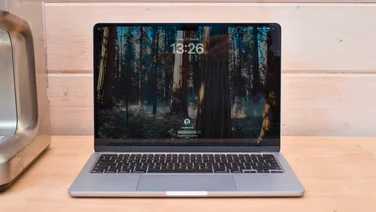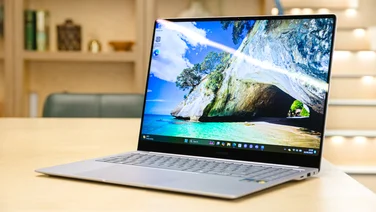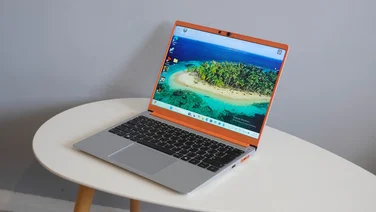To help us provide you with free impartial advice, we may earn a commission if you buy through links on our site. Learn more











- Impressive gaming performance
- Long battery life
- Two M.2 SSD slots
- Soldered RAM
- Wi-Fi 6E rather than 7
- All-white keyboard backlight
The little Asus TUF A14 is the first laptop we’ve tested here at Expert Reviews to come with one of Nvidia’s latest RTX 50-series “Blackwell” discrete GPUs. Unlike the previous generation of RTX 40-series GPUs, the new cards support three-level multi frame generation rather than the basic single-level frame generation introduced in the RTX40 cards.
It’s no exaggeration to say that multi frame generation (MFG) is a game changer in much the same way as the jet engine was. What came before did the same basic job, but the difference in performance was nothing short of revolutionary. That’s what MFG brings to gaming laptops, allowing you to run Triple-A games at high detail levels, and Ray Tracing at 2.5K resolutions, while still getting triple-digit frame rates.
Asus TUF Gaming A14 Review: What you need to know
Asus’ TUF gaming laptops (the acronym comes from The Ultimate Force, rather than a deviant spelling of Tough) sit below the Republic of Gamers or ROG machines, both in terms of price and purity of intent. They are aimed at buyers who want a laptop that can play games but is also usable in other, more general circumstances.











To that end, the design of the TUF machines tends to look less juvenile (or less exciting, take your pick), and the hardware is more balanced to minimise the usual gaming laptop weaknesses of abysmal battery life and fans that can wake the dead at full speed.
As a reviewer, this puts me in the odd position of having to hold TUF machines to a higher standard than the more expensive ROG models. The latter only has to be able to run games at a high frame-rate, but the former has to do much the same while not having awful battery life, weighing a ton or being thicker than War and Peace.
Price and competition
Configuration tested (FA401KM-RG003W): Octa-core AMD Ryzen AI 7 350 CPU, Nvidia GeForce RTX 5060 110W TGP GPU, 16GB RAM, 1TB SSD, 14in 2,560 x 1,600 IPS 165Hz display. Price: £1,599
Since this is the first Blackwell laptop we’ve tested, all our direct Windows comparators are running on previous-generation Nvidia 40-series Ada Lovelace GPUs. However, they still have some serious gaming capability. You can also expect to find them on sale in the coming months as the new RTX50 machines enter retail channels and old stock is cleared out.
- Acer’s Nitro 14 is worth a look, despite running on a previous-gen 110W Nvidia GeForce RTX 4060 GPU with 6GB rather than 8GB of VRAM, because it can be picked up for under £1,400. The keyboard is more overtly gamer friendly than the one on the A14, although you only get 512GB of storage
- The HP Omen Transcend 14 is a striking laptop, especially in the white colourway, built around a 65W Nvidia GeForce RTX 4060 GPU and a 16-core Intel Core Ultra 7 155H processor. Good looks, combined with a high-quality 14in 120Hz OLED display and excellent speaker system make this a desirable laptop, even at £1,699
- Lenovo’s Legion Slim 5 Gen 8 is also on the pricey side at £1,699 for the model with a 105W Nvidia GeForce RTX 4060 GPU and 32GB of RAM, but the 2.8K 14.5in 120Hz OLED screen is very colour-accurate, making this a great compact laptop for creative work
- Though not a gaming machine, Apple’s latest M4 Apple MacBook Pro 14 is a good alternative for anyone looking for a powerful, compact laptop. Display quality and battery life are class-leading, but you will have to make do with a 60Hz refresh rate and a limited games library
Design and features
The TUF A14 is an impressively solid little laptop, and like all Asus’ TUF notebooks, it meets a raft of MIL-STD-810H standards for resistance to particle ingress, temperature change and vibration. The body is made from plastic but still feels very solid, while the lid, which can be folded back flat to 180 degrees, is made from CNC-milled aluminium.
When it comes to colours, you have a choice of black or black. The paint finish does a good job of not showing fingerprints, but I still think it’s a shame Asus has abandoned the striking white casings of machines like the 2021 TUF Dash F15.
For a compact laptop, the A14 has a good selection of inputs and outputs, and they are sensibly placed and spaced. On the right, you’ll find 10Gbits/sec USB-C and USB-A ports, the former supporting DisplayPort video and a MicroSD card slot.











On the left side, there’s a USB-C 4.0 port which supports DisplayPort video and Power Delivery charging, a second 10Gbits/sec USB-A port and a 3.5mm audio jack. The slot for the 200W rat-&-tail charger is also on the left towards the rear, conveniently out of the way.
Wireless communications are handled by a RealTek RTL8852CE card that supports Wi-Fi 6E and Bluetooth 5.3. Not the latest iterations in either case, but the real-world implications of that are minimal.
For a gaming laptop, the TUF A14 is genuinely compact. It weighs less than 1.5kg, which is good for any laptop with a 73Wh battery, and at 311 x 227.5 x 20mm (WDH) it’s barely any larger than the heavier MacBook Pro 14.











Better still, it’s relatively simple to access the innards, and once inside it’s easy to add a second M.2 2280 SSD. You can’t add more RAM, though, because what you get at the time of purchase (either 2 x 8GB or 2 x 16GB) is soldered to the motherboard.
This being an Asus gaming laptop, albeit one of the more sensible TUF breed, you still get all the important bells and whistles like a manual MUX switch as well as Nvidia’s Advanced Optimus automatic GPU switcher and the same Armoury Crate control panel as the hardcore ROG Strix machines.
Keyboard, touchpad and webcam
The TUF A14’s keyboard looks and feels much like those on the latest Asus ROG Strix gaming laptops, with the major difference that on the TUF Gaming A14, you get a three-level white backlight with limited preset patterns rather than RGB lighting.
The similarity to the ROG laptop keyboards is a good thing. The TUF A14’s keyboard is solid, well-spaced, and has a gamer-friendly 1.7mm of key travel. The slightly stylised graphics are a model of clarity and it also comes with two features I always like to see: a keyboard Fn lock and four stand-alone keys to adjust the volume, mute the microphone and launch the system control panel.
As always, I’d prefer the cursor keys to be full-size rather than half-height, but given the form factor, I expected the smaller buttons. The only nit I can pick is the absence of anything to distinguish the WASD keys.











At 125 x 80mm, the glass touchpad is as big as it can be given the room below the space bar, and it works a treat. The surface is pleasant to touch, and the click-action is firm, quiet and perfectly damped.
The webcam is a run-of-the-mill 1080p affair, but the images it captures are crisp and reasonably colourful. All of the Windows Studio effects worked out of the box, and there’s support for Windows Hello IR facial recognition.
Display and audio quality
While there’s nothing wrong with the Asus’ 2,560 x 1,600 165Hz IPS screen, it’s still the weakest part of the package because it merely meets rather than exceeds expectations.
Peak brightness is a perfectly decent 445cd/m2 in SDR mode, but given the conventional edge backlight, there is no HDR option. Natively, it delivers 106% of the sRGB colour space, 75% of DCI-P3, and 73.1% of AdobeRGB, which limits the panel’s ability to display the sumptuous colours you would expect from a wider gamut display.











On the glass-half-full side of the equation, the screen is colour-accurate with a Delta E variance of just 1.3 compared to the sRGB profile, and the contrast ratio is good, too, at just shy of 1,500:1.
There’s no problem with motion fidelity, either, with very little ghosting or smearing to be seen, and the panel supports Nvidia’s G-Sync anti-tearing technology. The screen’s matte finish does a good job of keeping reflections in check.











And while 165Hz may seem a little on the low side for a modern gaming machine, I never found myself wanting anything higher while playing. Hardcore eSports players may not agree, but then the TUF Gaming A14 is not aimed at them.
The A14’s speakers didn’t cause my sound meter any problems, generating a rather low 71dBA when measured against a pink noise source at 1m, but that figure belies the overall high quality of the warm, detailed sound that the speaker system delivers. There’s a healthy amount of bass underpinning the audio proceedings.
Performance and battery life
Hauling the coal inside the Asus TUF Gaming A14 is an 8-core AMD Ryzen AI 7 350 CPU with a maximum clock speed of 5GHz, a 50 TOPS neural processor to handle those pesky local AI jobs and a Radeon 860M iGPU.
It’s a chipset designed to balance performance with efficiency, and as we’ll see it delivers, giving little away to on-paper more powerful CPUs while not pulling the battery’s pants down.
Of course, it’s the new GPU that’s the main point of interest. The frame rates Nvidia’s latest GPUs can deliver thanks to the latest incarnation of DLSS (Deep Learning Super Sampling) and Multi Frame Generation are truly a wonder to behold.
Cyberpunk 2077 ran at a pedestrian 21fps at 2,560 x 1,600 using the Ray Tracing Ultra setting and no performance enhancers engaged. With DLSS set to Auto, the frame rate jumped to 43fps. Engaging Multi Frame Generation boosted the frame rate to 71fps, moving it from the x2 to the x3 setting increased the frame rate to 92fps. In the x4 position, the frame rate averaged 119fps.
Drop the display resolution to 1,920 x 1,200, and that last figure jumped to 164fps, which is the fastest frame rate the display can physically render.
At this point, I’m sure you’re expecting me to say that with Multi Frame Generation set at x4, the picture quality dived, but I’d be lying if I said I spotted any degradation or artefacts in the single-player titles like DOOM: The Dark Ages and S.T.A.L.K.E.R. 2: Heart of Chornobyl that I ran on the TUF A14.
Even if we ignore Nvidia’s latest frame rate boosters, the GeForce RTX 5060 is noticeably more capable than the GeForce RTX 4060 found in the 2024 cohort of compact gaming laptops. The Asus ran our long-standing 1080p Hitman 2 benchtest at 63fps compared to the 110W TGP Acer Nitro’s 56.8fps, the 105W TGP Lenovo Legion’s 55.6fps and the 65W TGP Omen Transcend’s 40fps.
The discrete GPU also makes the TUF A14 a handy workhorse for demanding graphics jobs like 3D modelling. The SPECviewperf 3dsmax modelling benchmark ran at a tasty 102fps, considerably faster than the RTX 4060 alternatives.
Away from gaming, the TUF A14 continued to perform well. In our 4K multimedia benchmark, the A14 scored 389 points, putting it on a similar footing to the likes of the latest Apple M4 MacBook Pro, a laptop we described as “wonderfully powerful”.
Under stress testing, the A14 proved capable of running both the CPU and the discrete GPU at consistently high utilisation levels without the cooling system getting too loud or frantic and without the plastic base panel feeling like it was about to melt. After two hours, the GPU was running at 98% and 72 degrees Celsius.
As for storage performance, the 1TB Western Digital SSD recorded average sequential read and write speeds of 4,895MB/sec and 2,766MB/sec, respectively, which is more than adequate for the sort of large file movements you’d expect to make on a gaming laptop.
You seldom find the phrases “gaming laptop” and “good battery life” on the same page, but in our standard video rundown test using the VLC media player and with the screen set to 170cd/m2, the A14 lasted for just over thirteen and a half hours, which is a mightily creditable performance and a country mile ahead of the Windows alternatives. This truly is a hybrid machine capable of handling anything you can throw at it.
Asus TUF Gaming A14 review: Verdict
The Asus TUF A14 is a unicorn of a laptop. It’s surprisingly powerful for such a compact laptop. It has great battery life, which is unusual in any gaming portable. Finally, it doesn’t cost an arm and a leg, which is not something I expected given its broad spread of talents.
In fact, I’d go as far as to say that the TUF A14 is one of the most wholly rounded laptops I’ve encountered recently. I could happily live with it as a day-to-day laptop for use in the office and when travelling, but once home, I could plug it in and play DOOM: The Dark Ages with all the lighting and detail effects turned up to 11 at over 100fps. What’s not to like about that?
Asus TUF Gaming A14 Specifications
| Processor | AMD Ryzen AI 7 350 |
| RAM | 16GB |
| Additional memory slots | No |
| Max memory | 32GB |
| Graphics adapter | Nvidia RTX 5060 110W |
| Graphics memory | 8GB |
| Storage | 1TB SSD |
| Screen size (in) | 14 |
| Screen resolution | 2,560 x 1,600 |
| Pixel density (PPI) | 216 |
| Screen type | IPS 165Hz |
| Touchscreen | No |
| Pointing devices | Touchpad |
| Optical drive | No |
| Memory card slot | Yes, MicroSD |
| 3.5mm audio jack | Yes |
| Graphics outputs | USB-C DP AltMode x 1, HDMI 2.1 x 1 |
| Other ports | USB-C 4.0 x 1, USB-C 3.2 Gen 2 x 1, USB-A 3.2 Gen 2 x 2 |
| Web cam | 1080p |
| Speakers | Stereo |
| Wi-Fi | Wi-Fi 6E |
| Bluetooth | Bluetooth 5.3 |
| NFC | No |
| Dimensions, mm (WDH) | 311.1 x 227.5 x 19.9mm |
| Weight (kg) – with keyboard where applicable | 1.46 |
| Battery size (Wh) | 73 |
| Operating system | Windows 11 Home |






